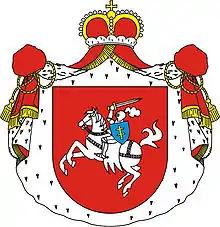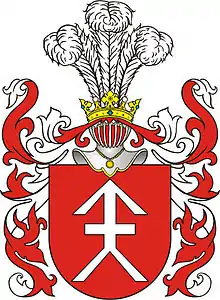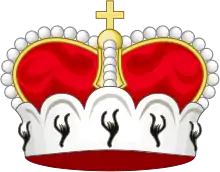Lithuanian nobility
The Lithuanian nobility was historically a legally privileged class in the Kingdom of Lithuania and Grand Duchy of Lithuania (including during periods of foreign occupation) consisting of Lithuanians, from the historical regions of Lithuania Proper and Samogitia, and, following Lithuania's eastern expansion, many Ruthenian noble families (boyars).[1] Families were primarily granted privileges for their military service to the Grand Duchy. The Polish–Lithuanian Commonwealth had one of the largest percentages of nobility in Europe, close to 10% of the population, in some regions, like Samogitia, it was closer to 12%. However, the high nobility was extremely limited in number, consisting of the magnates and later, within the Russian Empire, of princes.



In the Grand Duchy of Lithuania
Prior to the creation of the Lithuanian state by Mindaugas, lesser members of the nobility were called bajorai (singular - bajoras) and greater nobles, kunigai (singular - kunigas), related to the Old German: kunig, meaning "king", or Lithuanian: kunigaikštis, usually translated as duke, Latin: dux. These positions evolved from tribal leaders and were chiefly responsible for waging wars and organizing raids operations into enemy territories. Following the establishment of a unified state, they gradually became subordinates to greater Dukes, and later to the King of Lithuania. After Mindaugas' death, all Lithuanian rulers held the title Grand Duke (Lithuanian: Didysis kunigaikštis), or king (rex which was used in Gediminas' title).
Ethnic Lithuanian nobility had different names than common people, as their names consisted of two stems. Greater noble families generally used their predecessor's Lithuanian pagan given names as their family names; this was the case with Goštautai, Radvilos, Astikai, Kęsgailos and others. Those families acquired great wealth, eventually becoming magnates. Their representatives are respectively Jonas Goštautas, Radvila Astikas, Kristinas Astikas and Mykolas Kęsgaila. The aforementioned families were granted corresponding Polish coats of arms under the Union of Horodlo in 1413.
While at the beginning the nobility was almost all Lithuanian, with territorial expansion more Ruthenian families joined the Lithuanian nobility. As early as the 16th century, several Ruthenian noble families began to call themselves gente Ruthenus, natione Lithuanus.[2] A good example is the Chodkiewicz family, which attributed its ancestry to the House of Gediminas.
According to the military census of 1528, ethnic Lithuanian lands had 5730 horsemen, whereas the army of the Ruthenian lands of the Grand Duchy consisted of 5372.[3]
Evolution
In the late 14th century Grand Dukes Jogaila and Skirgaila began forming professional forces. Instead of calling all men to war, a class of professional warriors – bajorai (future nobles) – was formed. In the early 15th century, Vytautas the Great reformed the army of the Grand Duchy of Lithuania further: as there were not enough warriors, Vytautas relieved soldiers from taxes and labour on the land by granting them veldamai status, a class of dependent peasants.[4] At first the land was given to the serving men until death (benefice), but during the 14th and 15th centuries most of it became patrimony, granted by grace of the monarch. Whilst throughout the 14th century the Grand Duke possessed ownership of about ⅔ of the Duchy's land, the expanse of his direct ownership decreased to ⅓ by 1569.
In the 15th century, the noble social class was already formed and in full effect throughout Lithuania; for quite a long time social mobility remained open and anyone could become ennobled as a reward for services to the Grand Duke. In time, the influence of lesser nobles decreased while greater nobles acquired increasingly more power, especially during the interregnum fights following Vytautas' death.
Wealthier families were distinct from other nobles due to latifundia in different lands including Lithuanian, Ruthenian and even Polish. In the 15th century, the biggest landowners began to call themselves "lords" (ponai or didikai), and the Lithuanian Council of Lords was established to represent their interests. In time, most of them received titles such as dukes and counts, borrowed from the Holy Roman Empire. Grand Duchy of Lithuania offices were held almost exclusively by magnates.
In the 16th century, Lithuanian nobility stopped calling themselves bajorai; they adopted Polish term szlachta (Lithuanian: šlėkta) instead. Landlords called themselves ziemionys or ziemiane.[5]
Privileges
Following his distribution of state land, The Grand Duke became dependent on powerful landowners, who began demanding greater liberties and privileges. The nobles were granted administrative and judicial power in their domains and increasing rights in state politics. The legal status of the nobility was based on several privileges, granted by the Grand Dukes:
- In 1387 the Grand Duke of Lithuania, Jogaila, newly crowned King of Poland, granted a privilege to nobles and soldiers. They received personal rights, including the right to inherit and govern land as well as estates inherited from ancestors or gifted by the Grand Duke. At the same time, the nobles had duties to serve in the military, build, maintain and safeguard castles, bridges, roads and other vicinities.
- In 1413 Vytautas and Jogaila signed Union of Horodło. The act served to renew Polish–Lithuanian union and establish a common Sejm, guaranteeing the right to inherit lands gifted by the Grand Duke. Forty-three Lithuanian noble families were granted Polish coats of arms. Most of the veldamai became serfs.
- Jogaila's privilege in 1432 in essence repeated previous acts. Military service remained the primary means to receive land.
- Privilege of May 6, 1434 was granted by Sigismund Kestutaitis to Catholic and Eastern Orthodox nobility. They were guaranteed freedom to dispose of their land. Significantly, the act also prohibited persecution without a fair trial.
- In 1447 Casimir I Jagiellon limited positions within the Catholic Church or state institutions only to people from Lithuania. Certain nobles were released from their duties to the Grand Duke. This privilege also marked the beginnings of serfdom in Lithuania, as peasants were removed from the Grand Duke's jurisdiction.
- 1492 privilege by Alexander Jagiellon renewed the 1447 privilege and added a few more provisions, the most important of which limited the Grand Duke's rights in regards to foreign policy. The Grand Duke became dependent on the Lithuanian Council of Lords. Without the consent of the Council no high official could be removed from his position. Lower posts had to be appointed in the presence of voivodes of Vilnius, Trakai, and other voivodeships. The privilege also prohibited selling various state and church positions to nobility. In turn, the Grand Duke was limited from exploiting conflicts between higher and lower nobility and profiting by selling the positions. This privilege also signified that city residents could not become officials.
- In 1506 Sigismund I the Old confirmed the position of the Council of Lords in state politics and limited acquisition of positions within the noble class.
- On April 1, 1557, Sigismund II Augustus initiated the Wallach reform, which completed the establishment of serfdom. The implementation of serfdom deprived the peasants of land ownership as well as personal rights, making the serfs completely dependent on nobles.
- Union of Lublin in 1569 created the new state, the Polish–Lithuanian Commonwealth. The nobility was granted the right to elect a common ruler for Poland and Lithuania.
- The Third Statute of Lithuania, completed in 1588, further expanded the rights of nobility. Laws could be enacted only by the general sejm. The nobility was granted triple immunity: legal, administrative and tax exemption. The statute finalized the division between nobility, peasants, and city residents.
Most of the nobility rights were retained even after the third partition of the Polish–Lithuanian Commonwealth in 1795.
Ties to the Kingdom of Poland
Following the Union of Horodło (1413), the Lithuanian nobility acquired the same rights as the ruling class of the Kingdom of Poland (szlachta). During the following centuries, the Lithuanian nobility began to merge with Polish nobility. The process accelerated after the Union of Lublin (1569), resulting in the Polish–Lithuanian Commonwealth.
Lithuanian nobility polonised, replacing Lithuanian and Ruthenian languages with Polish although the process took centuries. In the 16th century, a newly established theory amongst Lithuanian nobility was popular, claiming that Lithuanian nobility was of Roman extraction, and the Lithuanian language was just a morphed Latin language.[6][7] By that time, the upper nobility and the ducal court already used Polish as their first language.[8] The last Grand Duke known to have spoken Lithuanian was Casimir IV Jagiellon (1440-1492).[9] In 1595 Mikalojus Daukša addressed Lithuanian nobility calling for the Lithuanian language to play a more important role in state life.[9][8] The usage of Lithuanian declined, and the Polish language became the predominant administrative language in the 16th century,[10] eventually replacing Ruthenian as the official language of the Grand Duchy in 1697.[11] Nonetheless, spoken Lithuanian was still common in the Grand Duchy courts during the 17th century.[9]
At first, only Lithuanian magnate families were affected by Polonization,[9] although many of them like the Radziwiłłs remained loyal to the Grand Duchy of Lithuania and safeguarded its sovereignty vis-à-vis the Kingdom of Poland. Gradually Polonization spread to a wider population, and for the most part, the Lithuanian nobility became part of both nations’ szlachta.
The middle nobility adopted the Polish language in the 17th century, while the minor rural nobles remained bilingual up to the period when the question of language related-nationality appeared.[10]
The Lithuanian nobles did preserve their national awareness as members of the Grand Duchy,[8] and in most cases recognition of their Lithuanian family roots; their leaders would continue to represent the interests of the Grand Duchy of Lithuania in the General sejm and in the royal court.
Lithuanian language was used during Kościuszko Uprising in the proclamations calling to rise up For our freedom and yours. And Lithuanian nobles did rise to fight for the independence of their nation.
After partitions of the Polish–Lithuanian Commonwealth
In Lithuania proper, the Polonization of the nobility, gentry and townspeople was practically complete by the early 19th century, relegating the Lithuanian language to the status of a peasant's tongue.[9][12] The processes of Polonization and Russification were partially reversed with the Lithuanian National Revival. Despite origins from mostly the non-noble classes, a number of nobles re-embraced their Lithuanian roots.
The lesser Lithuanian nobility, still partially preserving the Lithuanian language,[13] subsequent to the partitions of the Commonwealth left most of the former Grand Duchy under control of the Russian Empire. The situation worsened during the years of tzar Nicholas I of Russia's rule. After the November uprising imperial officials wanted to minimize the social base for another potential uprising and thus decided to reduce the noble class. During the period of 1833–1860, 25,692 people in Vilna Governorate and 17,032 people in Kovno Governorate lost their noble status. They could not prove their status with monarchs' privileges or land ownership.[14] They did not lose personal freedom, but were assigned as one steaders Russian: однодворцы in rural areas and as citizens in towns.
In view of the January Uprising, imperial officials announced that "Lithuanians are Russians seduced by Poles and Catholicism" and banned press in the Lithuanian language and started the Program of Restoration of Russian Beginnings.
Over the course of time, the Lithuanian nobility increasingly developed a sense of belonging to the Polish nation.[15] During the 19th century, a self designation, often represented using a Latin formula gente Lithuanus, natione Polonus (Lithuanian by birth, Polish by nationality) was common in the Lithuania Proper and former Samogitian Eldership.[16] With Polish culture developing into one of the primary centers of resistance to the Russian Empire, Polonization in some regions actually strengthened in response to official policies of Russification. An even larger percentage of Lithuanian nobility was Polonised and adopted Polish identity by the late 19th century. A Russian census in 1897 showed that 27.7% of nobility living within modern Lithuania's borders recognized Lithuanian as the mother language.[17][18] This number was even higher in Kovno Governorate, where 36.6% of nobility identified the Lithuanian language as their mother language.[17]
Most descendants of the Lithuanian nobility remained ill-disposed to the modern national movements of Lithuania and Belarus and fought for Poland in 1918-1920.[15] The landowning nobles in the new Lithuanian state saw themselves predominately as Poles of Lithuanian background.[19] During the interbellum years the government of Lithuania issued land reform limiting manors with 150 hectares of land while confiscating land from those nobles who were fighting alongside the Polish in Polish-Lithuanian War. Many members of the Lithuanian nobility during the interbellum and after the World War II emigrated to Poland, many were deported to Siberia during the years 1945–53 of Soviet occupation, many manors were destroyed. The Association of Lithuanian Nobility was established in 1994.[20]
Heraldry
The most ancient heraldry has a motive of crossed arrows. According to the Union of Horodło of 1413, 47 Lithuanian noble families adopted Polish nobility coat of arms. Later more families adopted more coat of arms.
Influential Lithuanian families
Families from ethnic Lithuania
- Chodkiewicz (Chodkevičiai)
- Alelkaičiai (Olelkovich, Olekowicze)
- Alšėniškiai[21][22]
- Astikai (Ościkowicze)
- Balnyte
- Borkowski (Borkowscy, Borkowskiemu)
- Czartoryski (Čartoriskiai)
- Gedgaudai
- Gediminids (Gediminaičiai)
- Giedraičiai (Giedroyć)
- Goštautai (Gasztołdowie)
- Kęsgailos
- Mangirdaičiai
- Mantautaičiai
- Pac (Pacas)
- Piłsudski
- Purickas (Puricki) (Puriška)
- Radziwiłł (Radvila)
- Sakowicz
- Siručiai
- Sudimantaičiai
- Sviriškiai
- Valmantaičiai
Families from Europe
- Clan Ostoja (family of Casimir Siemienowicz
Family PetroDunmbroski, dumnbroski (family of indigenous Polytheistic and judeo nobles related to the Grand Duchy Jagiellonian dynasty
Families from Ruthenia
- Danielewicz
- Gulka
- Hlebowicz
- Krupski
- Ogiński (Oginskiai)
- Ostrogski (Ostrogiškiai)
- Sapieha (Sapiegos)
- Tyszkiewicz (Tiškevičiai)
- Wiśniowiecki (Višnioveckiai)
- Zasławski
Muscovite and later Russian princely and noble families originating in Lithuania
- Golitsyn
- Kurakin
- Khovansky
- Trubetskoy
- Woroniecki
- Nieswicki
- Volynsky
Families from Republic of Venice
- Dražba (Dražbos)
Families from Republic of Florence
Families from Republic of Lucca
- Moriconi
Families from Ferrara and/or Modena
- Carpi
See also
- List of early Lithuanian dukes
- List of Lithuanian rulers
- Germanic monarchy for references to Germanic synonym of kuningaz (Modern German: König, English: king).
- Szlachta
- List of szlachta
References
- Timothy Snyder, The Reconstruction of Nations, p. 22, 2003 New Haven & London, Yale University Press, ISBN 978-0-300-10586-5
- Bumblauskas, Alfredas (1995). "About the Lithuanian Baroque in a Baroque Manner". Lituanus. 41 (3). ISSN 0024-5089. Retrieved 2007-09-22.
gente Ruthenus, natione Lithuanus
- Jerzy Ochmański, Dawna Litwa, Wydawnictwo Pojerzierze. Olsztyn, 1986.
- Kiaupa, Zigmantas; Jūratė Kiaupienė; Albinas Kunevičius (2000) [1995]. The History of Lithuania Before 1795 (English ed.). Vilnius: Lithuanian Institute of History. pp. 172–174. ISBN 9986-810-13-2.
- Jučas, M. (1995). "Gyvi istorijos puslapiai". Lietuvos bajoras (in Lithuanian). Danielius. 1: 10–13. ISSN 1392-1304.
Tikruosius bajorus - luomą su pilietinėmis teisėmis - imta vadinti iš lenkų perimtu žodžiu „šlėktomis“, arba ziemionimis (ziemiane, szlachta). ... Istoriškai neturėtume vadinti Lietuvos kilmingųjų žemvaldžių bajorais, nes jie nuo XVI a. vidurio taip savęs niekur nebevadino.
- Gudmantas, Kęstutis (2004). "Vėlyvųjų Lietuvos metraščių veikėjai ir jų prototipai: "Romėnai" (The personages of the Lithuanian chronicles and their prototypes: The "Romans")". Ancient Lithuanian Literature. XVII: 113–139.
- unlikely, especially because the Romans had very little hold, if any, in the lands so far north) (see also sarmatism
- Stone, Daniel (2001). The Polish-Lithuanian State, 1386-1795. University of Washington Press. p. 63.
- Sužiedėlis, Saulius (1981). "Language and Social Class in Southwestern Lithuania before 1864". Lituanus. Lituanus Foundation. 27 (3): 36–37.
- Žukas, Saulius (1999). Lithuania: Past, culture, present. Baltos lankos. p. 77.
- Kołodziejczyk, Dariusz (2011). The Crimean Khanate and Poland-Lithuania: International Diplomacy on the European Periphery (15th-18th Century). A Study of Peace Treaties Followed by Annotated Documents. BRILL. p. 241.
- Butterwick, Richard (2012). The Polish Revolution and the Catholic Church, 1788-1792: A Political History. Oxford University Press. p. 5.
- ALEKSANDRAVIČIUS E., KULAKAUSKAS A. Carų valdžioje: XIX amžiaus Lietuva. Vilnius, 1996.
- Aleksandravičius, p.207
- Kotljarchuk, Andrej (2006). In the Shadows of Poland and Russia: The Grand Duchy of Lithuania and Sweden in the European Crisis of the Mid-17th Century. Stockholm University. pp. 282–283.
- Russia saved Lithuanian nation from becoming Polonised http://archive-lt.com/page/453644/2012-10-16/http://www.lietuviais.lt/straipsnis/Lietuvos-istorija/Lietuva-ir-Rusija-suklastota-istorija.php%5B%5D
- Aleksandravičius, Egidijus; Antanas Kulakauskas (1996). Carų valdžioje. Vilnius: Baltos lankos. pp. 232–233. ISBN 9986-403-69-3.
- Vėbra, Rimantas (1990). Llietuvių visuomenė XIXa. antrojoje pusėje. Mokslas. p. 152. ISBN 9986-403-69-3.
- Liekis, Šarūnas (2010). 1939: The Year that Changed Everything in Lithuania's History. Rodopi. p. 28.
- "Lietuvos bajorų karališkoji sąjunga - Home". www.lbks.lt. Retrieved 3 November 2017.
- Jonynas, Ignas (1933). "Alšėniškiai". In Vaclovas Biržiška (ed.). Lietuviškoji enciklopedija (in Lithuanian). I. Kaunas: Spaudos Fondas. pp. 347–359.
- Jonas Zinkus; et al., eds. (1985). "Alšėnų kunigaikščiai". Tarybų Lietuvos enciklopedija (in Lithuanian). I. Vilnius, Lithuania: Vyriausioji enciklopedijų redakcija. p. 52.
Further reading
- (in Lithuanian) Rimvydas Petrauskas Giminaičiai ir pavaldiniai: Lietuvos bajorų grupės XIV a. pabaigoje-XV a. I pusėje in: Lietuva ir jos kaimynai: nuo Normanų iki Napoleono: prof. Broniaus Dundulio atminimui. Vilnius, 2001, p. 107-126.
- (in Lithuanian) Rimvydas Petrauskas, Lietuvos diduomenė XIV a.pabaigoje - XV a.:sudėtis-struktūra-valdžia. Aidai, Vilnius; 2003.
- (in Lithuanian) N. Asadauskienė, V. Jankauskas, V. Kamuntavičienė, Lietuvos didikai (Lithuanian noblemen). Šviesa, Vilnius; 2011. ISBN 978-5-430-04453-4
- Kiaupienė, Jūratė (2003). Mes, Lietuva: Lietuvos Didžiosios Kunigaikštystės bajorija XVIa. Viešasis ir privatus gyvenimas (in Lithuanian). Vilnius: Lithuanian institute of history. ISBN 9955-595-08-6.
- Aleksandravičius, Egidijus (1999). "The double fate of the Lithuanian gentry". Lituanus. 45 (3). Retrieved 2007-09-06. Historiographical notes on the research of Lithuanian nobility.
- Schmalstieg, William R. (1982). "Lithuanian names". Lituanus. 28 (3). Retrieved 2007-09-06.
External links
- J. Lyčkoŭski. "The Gentry of the Grand Duchy of Lithuania". The Alphabetical Lists. (in Polish)
